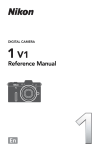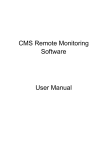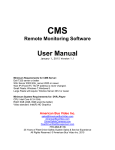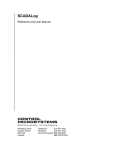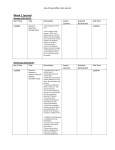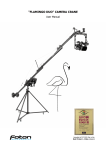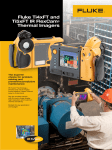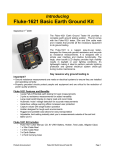Download with a Fluke 287/289 Digital Multimeter
Transcript
Event recording (or logging) with a Fluke 287/289 Digital Multimeter One of the major features of the Fluke 280 Series digital multimeters (DMM) with TrendCapture is their ability to record measurement data or “do logging.” This application note explains what kind of logging these meters can perform, how to use the recording feature, and what information it can provide. This note also discusses how to use FlukeView® Forms PC software to increase the power of the Recording feature. For the balance of this note, we will refer to the Fluke 289 DMM, although the information is equally applicable to the Fluke 287 DMM. Application Note Note: This article references features included in a firmware upgrade to the 289 DMM released in August, 2008. To obtain the latest firmware version, visit www. fluke.com/software-downloads. For a summary of the changes, reference the end of this document. Differences between the Fluke 289 DMM and a data logger The Fluke 289 does not do data logging in the traditional sense. Typically, the goal of a data logger is to sample the input signal at a rate sufficient to track activity that you might find in the signal. This often means that it is desirable to sample the input as fast as possible so you don’t miss anything. The problem with this approach is you need a large storage place for the fast data sampling that is taking place. You can also end up wading through a lot of redundant data that is considered “normal” to find the exceptional data (or lack thereof). The difference between the Fluke 289 DMM and a traditional logger is that the DMM, while sampling internally at a sub-second rate, records only significant changes in the readings. This technique, called event recording, requires far less memory. Still, it does an effective job of monitoring and logging data from an input signal, enabling you to detect if and when the monitored system is operating abnormally. The other difference is that the Fluke 289 DMM can graph the data onscreen in TrendCapture mode, immediately after the recording session is completed. TrendCapture is a major enhancement in the 28X family over the previous logging capability of the 189, which had to upload each recording session to software to graph and view the results. The Fluke 289 uses similar graphing software (optional) for detailed analysis, but its ability to graph even rough details immediately, onscreen, can be very powerful. In addition, the 28X can now hold multiple recording sessions in it’s memory allowing troubleshooters to get multiple sets of data, possibly at different locations, without having to download each session as in the past. Introduction to event recording Event recording can be thought of as an extension of the “Touch Hold” feature of the original Fluke 87 DMM. (Touch Hold is now called “Auto Hold” on the 287/289.) When the Auto Hold feature is activated, the meter waits until a period of stability From the Fluke Digital Library @ www.fluke.com/library has been reached, then it beeps and freezes (holds) a stable reading on the display for the user to see. If the input changes to the point that it is no longer stable, then becomes stable again, the meter will beep a second time and hold a new reading on the display. Event recording uses a similar scheme. When the Fluke 289 is recording, it is looking for periods of stability. For each stable or unstable period the meter logs a start time, the initial reading, stop time, the maximum reading, minimum reading (and the times of their occurrence) and average reading during that period. The event recording feature is designed to store only enough information to describe any changes; i.e., events, to the input signal. Event recording data The Fluke 289 excels at recording transition events, but while it has TrendCapture graphing capability, it does not have the kind of large graphical display resolution needed to analyze all of the event data. This is where FlukeView Forms software takes over, allowing you to view the recorded data in table or graph form on a PC. An example is shown in the figure below. Looking at this data, you can see that the recording session started at 1:54:41 PM and ended at 2:23:47 PM with an elapsed time of about 29 minutes. You can also see that the signal being measured was stable near 119 V for most of the logging session. However, there was one unstable event detected by the meter during a 1.6-second period beginning at 2:18 PM. The graph clearly shows the switching event that happened at that time. What is interesting about this example is that the table of data shows only six “events” needed to be stored in the meter memory over the entire 29 minutes of logging to capture the essence of what happened. What this illustration shows is that, with event recording, only a very small amount of memory is needed to store the information. To capture the same data using traditional data logging would require a one-second sample rate over the entire 29 minutes which would have produced 1,740 records of data, yet that level of detail was not required to detect the problem. Recording—by the numbers Now that we know how the Fluke 289 records data, let’s go through the step-by-step process for recording a desired signal over time. In this case, the test will record the signature of the current drawn by a large household refrigerator for more than one day. The following steps can be generalized to any recording situation. Figure 1. 2 Fluke Corporation Event recording (or logging) with a Fluke 287/289 Digital Multimeter Step 1 Make sure that the battery indicator in the upper left hand corner of the Fluke 289 display shows at least two of the possible four bars, indicating enough charge is left for a 24-hour operation. For any longer recording period, or if in doubt, replace the batteries with fresh new ones. Step 2 Connect the meter to the circuit being measured. In this example, the ac current was measured by connecting a current transformer probe to the mA jacks of the Fluke 289. That is because the probe output is 1 mA/A. We then place the jaws of the probe around the circuit conductor in the distribution panel that is connected to the breaker dedicated to the refrigerator. If the DMM function switch is in any position except A/mA or μA, the meter will beep to indicate that the switch must be in one of these two positions to proceed, and the display information screen will show the details. In this case, we want the A/mA function. The meter will sense the presence of the lead in the mA jack, and select the proper circuit for the recording. Note: Although not required in this case, if a signal normally varies a full point, you might want to estimate a maximum current or voltage that you expect to encounter, and set manual ranging to the higher range. This will prevent recording multiple events due to auto-ranging. Step 3 Press the Save (F2) softkey and highlight the Record option using the navigation arrows. Then, press the Record (F1) softkey below the display. At this point, the Recording information screen appears. Note that the bottom line of this display indicates the battery condition. If the battery is partially discharged, the Battery: partly empty advisory appears. See step 1 above. Step 4 Using the navigation arrows, highlight Set Duration and press Edit (F1). Edit the duration setting to 07 Days 00 Hrs 00 Min. (We can always manually stop the recording procedure earlier if we like.) Note: Recording duration and sample interval times may interact — setting one variable may adjust the other to fit the recording session within the available memory. Step 5 When Duration and Sample Interval settings have been changed to desired values, press OK (F1) to accept the changes. Step 6 Press the Start (F2) softkey to begin recording. You can now leave the meter unattended. The 289 will record the current (amps) used by the refrigerator. Note: While recording is active (1) the power button LED will flash on and off, (2) five minutes after any button press, the display will turn off to conserve battery power. Press any button to turn the display back on, and (3) the display will show the start time, the remaining time and number of recorded interval samples and events. Step 7 Recording is stopped in three ways: (1) Automatically when the recording duration time has reached, (2) Automatically when the battery level becomes critically low or (3) Manually by pressing the Stop (F4) softkey. When recording is stopped, the power button LED will stop Important These next steps (7 through 9) should be performed immediately after the test is ended, or when you return to retrieve you meter, before you explore the data on screen. This is to make sure you save the recorded data in a known and easy to recall location. flashing on and off. Note that once the recording session has stopped, you cannot resume that session. Using TrendCapture You may now safely press the Trend (F3) softkey to view the stored results in graphiNote: Returning to Stopped Screen cal format. A vertical cursor after meter auto powers off: When will appear in the center of the recording ends automatically due to TrendCapture display. Using the duration time being reached, the disnavigation keys, you can move play is turned on (if it had been off) and the meter will power off accordthis cursor over areas of interest ing to the Auto Power Off setting in in the graph and the value and Instrument Setup (never or N minutes). time of recording for that value If the recording ends due to the battery becoming critically low, the meter will appear. will immediately power down. Turn the meter back on. If the battery is showing empty, turn the meter off and replace the batteries. Turn the meter back on. The meter will start showing the display as if you were at the start of Step 8. Step 8 Press Save (F2) to bring up the Save display. Step 9 Press the +Name (F1) softkey to select the recording session name to be associated with this saved data. In this case, since it is a recording, you might choose to highlight Recording and note that a boxed number appears. This number is automatically incremented each time you do a save using that save name. Note this saved name (including its number) so that you can easily identify the source of the data in memory after you upload it to FlukeView Forms. That’s because you could easily have ten or more recordings in memory before you return to a computer. Step 10 Now, press Save (F1) one more time to complete the storage of the test data in the DMM memory. The display screen will now show the Start time, the Duration of the test, and the number of Interval samples and Events that were stored. Congratulations! You have successfully completed a recording session and saved the results in the meter. You can now turn the meter off, or use it for other purposes until you choose to transfer your data to a computer. 3 Fluke Corporation Event recording (or logging) with a Fluke 287/289 Digital Multimeter 06/01/08 x1 05/30/08 07:03:09pm 08:35 am 16 m A A C 12 8 4 0 00:00 09:30 19:00 28:30 37:33 1.830 mAAC 01:57:42pm HH:MM Figure 2. Single refrigeration cycle. The first thing to note is that the graph has been scaled to 20 mA. Here’s what’s happening. The current level was mostly at about the 2 mA level when the compressor was running. The 18 mA “spikes” show the momentary motor starting current each time the compressor ran. The blank gap near the center of the screen is interesting, so now we’ll use the TrendCapture Zoom feature, using the updown navigation keys, to look at the detail. 06/01/08 x3 05/30/08 07:03:09pm 08:35 am 16 m 12 A A 8 C 4 0 14:36 16:36 18:36 20:36 22:36 1.944 mAAC 02:21:01pm HH:MM Figure 3. Single cycle, zoomed. While in Trend mode, the F3 menu selection changes to Summary. Press the softkey to see the session summary data, including the Start Time and Duration of the recording and the number of Interval Samples and Events recorded. The main display shows the last recorded value in the session. Note: Time scale for Figure 2 and 3 is elapsed time. Use TrendCapture immediately after recording to do a brief inspection of the recorded data for any suspicious events that might suggest further testing. You can also use it later, in conjunction with the Summary screen, to evaluate or identify multiple saved files in the meter if you didn’t note the saved session name at the time of recording. Remember: TrendCapture can only be used to review recorded data—either the session just completed or a saved data file—it cannot graph in real-time. If you attempt to use TrendCapture during a recording session, you will terminate the recording. right side of the window. This data will automatically copy to the displayed Form (Figure 4b.) You should see a ‘connected’ icon with the port identified in the lower right part of the display. If there are port conflicts, you may see the Options window appear, where you will have to select an available unused port. Press OK when you see the ‘connected’ icon appear. The next pop-up window to appear should be Get Meter Data—Fluke 289/287. It will ask you if you want to Get meter data now? If this window doesn’t appear automatically, you may select Meter on the menu bar and then select Get meter data… from the drop down list. Step 4 If the recording you want is not the last one recorded, then you must open the pull down window in the upper left corner of the window and select Data Sessions. A table will appear showing the Session Name, Session Type, Start Time, and Number of Readings for each session saved in the meter. See Figure 5. Step 5 Select the desired Recording and press Get Session Data. When the upload is complete, the selected recording will be Uploading recorded data present and you can Copy into to FlukeView® Forms. Form. Step 3 In our example (Figure 6), The next steps describe how to Press OK to begin the upload Recording 4 spanned nearly 42 transfer the recording results to process. If the data you’re tryhours of refrigerator operation. FlukeView Forms, where you can ing to upload is the last session What we see on the graph is the complete reports that include you recorded, then the data you repeated cycle of turn-on (the graphs, showing what hapwant will be displayed in the 18 amp narrow spike), comprespened to the refrigerator during FVF Virtual Meter “memory” sor run (a few minutes at 2 to 3 the time it was being recorded. screen. You can verify this by amps), and off time (more than You can also program certain viewing the summary informafunctions of the meter from your tion at the bottom of the window 15 minutes at 0.0 amps.) A quick glance at the graph computer while it is connected. that appears. (Figure 4a.) Then shows an unusual event (highselect Copy into Form on the Note: This process assumes you lighted by the dashed circle) already have FlukeView Forms installed on your computer. Step 1 Using the IR-USB cable, connect the meter to your computer. It’s best to have the meter in the active measurement mode (not in setup or any of the save/record/ view functions) while connected to your computer. When connecting the IR connector to the meter, verify that the Fluke logo on the IR connector is visible when viewing the display of the meter. Now, turn the meter on. Figure 4a. Summary information Figure 5. Note: The meter cannot upload data while memory or TrendCapture information is being displayed. Step 2 Start FlukeView Forms on the computer. The ‘New Blank Form’ window will appear. For our refrigerator example, select Sample Logging Form (short) and then press OK. Figure 6. 4 Fluke Corporation Event recording (or logging) with a Fluke 287/289 Digital Multimeter Figure 4b. Figure 7. near midnight on Thursday morning. First, the running current was near 5 amps, and then the following cycle lasted for much longer than normal. What we have discovered is the occasional defrost cycle that is a feature of this refrigerator. The 5 amp portion is the operation of the defrost heater, and the longer next cycle is an extended compressor run to remove the excess heat. Zoom choices as well as many other options affecting the graph (Figure 7.) The highlighted Manual Zoom allows you to precisely locate the area of interest using the time scale at the bottom of the graph. In our example in Figure 8, we show the period from 10:00 PM on Wednesday to 2:15 AM Thursday morning—when the defrost cycle occurred. Here you can see a few normal cycles, then the defrost cycle and recovery, and finally the return to normal cycles. There are three more features in FlukeView Forms that you should be aware of. The first allows you to examine the detail for a selected point on the graph. This feature is revealed by moving your screen cursor to the point of interest until the cursor changes to a pointing finger. For our example, we’ll choose the beginning of the 6 amp reading. Then, left-click and hold to see a pop-up window with detailed information for the selected sample. (Figure 9.) This feature gives you instant detail regarding a point of inter- est in your recording. You’ll note that reading 298 was an Interval which only lasted 11+ minutes rather than the normal 15 minutes. The likely reason was that the interval was interrupted by a sudden change in the meter input. Second, to look at the detailed information recorded around the event of interest, look to the Logged Reading Table just below the graph on your form. (Figure 10.) Scrolling to reading 298, we see the interval in question in detail. And, reading 299 was an unstable event that shows the time the defroster heater turned off. Tip: To copy FVF information to other documents, right-click on the Logged Reading Table and or other Fluke View Forms graph and use the “copy” option. Figure 8. A similar event might be the operation of an ice dispenser as it crushes ice, or the ice maker as it refills and freezes new ice cubes. FlukeView Forms has a Zoom feature that allows us to look closely at an event of interest in greater detail. You can click and drag a box around the area of interest, or you can right click anywhere on the graph to see a pop-up window with several Figure 9. 5 Fluke Corporation Event recording (or logging) with a Fluke 287/289 Digital Multimeter Third, notice the extensive file naming and storing options in the meter hinted at in the Data Session selection window in Figure 4. Note that the meter stores multiple sessions with the user-selected Session Name, Session Type, Start Time, and Number of Readings. Figure 10. Session names are available in several categories and use self-incrementing numbers for each session in a selected type. The meter can record four session types: Measurement, Min Max, Peak, and Recording. You can store sessions in any one of the Name categories you choose, although it’s generally a good idea to use the Measurement name category for individual measurement saves and the Recording name for long logging sessions, just to keep things organized. Wrapping it up This is only a brief description of Event Recording using the Fluke 289, and the added power provided by the companion PC software, FlukeView Forms. In our example, we used only 405 readings to capture the current used by a refrigerator over nearly 42 hours of recording, yet, the meter was able to detect 239 instances of unusual events, down to the second they occurred, for our later inspection. This step-by-step example following one recording session from the meter recording process into TrendCapture and then FlukeView Forms is intended as an introduction to the power of Event Recording in the Fluke 289. We recommend further exploring these features at your leisure. Selected recent updates to FlukeView Forms Software (v3.4) Screen Shots from the meter With the introduction of version 3.4 of FlukeView Forms, it is now possible to save screen shots from a connected Fluke 287/289 digital multimeter. The procedure for saving a screen shot is as follows: 1. On the meter, select the screen to be saved as the current meter display. 2. In FlukeView Forms (connected) click the Meter icon. 3. In the upper left-hand corner of the 289/287 import window select Meter Display. 4. On the right hand side of the active display window, select the Get Screen Shot button. The Fluke 289/287 Screen Shot save window will appear. Select the folder and specify a file name for the file to be saved. The file saved will be a zip file with an extension .bmp. The screen shot can then be unzipped as a JPG or other file format and placed on a FlukeView Forms Bitmap object in your chosen form. It may also be used in other software applications, or emailed if desired. Changing or adding data to the meter from FlukeView Forms There have been several additions to the ability to upload information to the meter from FlukeView Forms. From the menu, select Meter-Change Meter Setup. The window that appears shows everything that may be changed in the meter. (To change a name in the meter’s #Name list, click on the Edit Name List button at the bottom of the window.) Changing FlukeView Form items to accept information When you have uploaded Operator Name information from FlukeView Forms to the meter (to be viewed on the meter using Setup-Meter Info), the added Operator Name will be appear in FlukeView Forms when you download data from the meter. It will appear in the FlukeView Meter Information form item. If you’re using one of the sample forms delivered with the software, this item may be shown on your form with the Serial No. label. Make sure you expand this item on the form (using FlukeView Forms Designer) to display this second line of information. You might also want to change the label to something more appropriate, such as “Meter Info”, since the field now displays more than just a serial no. 6 Fluke Corporation Event recording (or logging) with a Fluke 287/289 Digital Multimeter Firmware updates to Fluke 287/289 Digital Multimeters The internal programs of these meters are stored in flash memory. As a result, Fluke can now offer product updates and improvements from time to time. This sidebar summarizes new additions to the Fluke 289/287 firmware with version 1.1. Where applicable, these feature changes have already been incorporated into the main body of this application note. The updated firmware may be downloaded from the Fluke website at www. fluke.com/software-downloads and installed using the USB connecting cable furnished with FlukeView Forms software. Any future firmware updates for the Fluke 287/289 Digital Multimeters will include these same features. Page numbers () are indicated to help you locate details of these features in the updated user manual available online in pdf format at www.fluke.com/289-manual. Recording and display (TrendCapture) 1. Basic settings for a recording session have been simplified and clarified. (53-54) Recording setup is accessed using the SaveRecord soft-keys. In the Recording Menu, you now select only Duration of recording and Sample Interval. Percentage of available memory and battery condition are reported. 2. Event Threshold Value (%) for AutoHOLD and Recording can now be set in the meter. (54) Previously, it was necessary to make this setting using FlukeView Forms software from a connected computer. (Default values are 4 % for both functions.) Threshold value setup is accessed using the Setup-Recording soft-keys. On the Recording Setup screen, you may now select Event Threshold to adjust the AutoHOLD threshold value and adjust using the cursor keys for values between 1 % and 30 %. Event Threshold for Recording may be turned off, if only interval recording is desired, or set to one of seven selected values between 1 % and 25 %. 3. The TrendCapture graphic display of events recorded by the meter has been improved to more clearly indicate the activity of a device being recorded. No change in user operation is required to make use of this improved display. 4. A new Zoom feature has been added to the Trend Data display that expands the graph to show more details of unusual events (51) To use this new feature, first position the vertical cursor bar over the point of interest in the Trend Data display (using the left and right arrows) and then press the up arrow to magnify the display by two, centered on the cursor position. You can do this repeatedly until the desired resolution is achieved. Zoom back out by using the down arrow. Date and time are reported above the graph along with the zoom level (full display is x1). The recorded value at the cursor position and the time it was recorded are reported under the graph. Other features, additions, and updates 1. When switching to the current measurement functions (A/mA or uA) the meter will ‘remember’ the last used selection for ac or dc. (39) Once in this function, the same setting will hold between A, mA and uA. This feature is useful when the operator is using ac only or ac+dc current clamp accessories, to minimize repeat setup actions. 2. A Smoothing mode may be enabled for ac measurements. (49) This feature allows you to select a filter to smooth noisy ac readings. Smoothing options are accessed using the Setup-Instrument soft-keys. Under Edit, you can then turn the smoothing function on or off using up-down arrow keys. 3. You can add your name, company name, worksite, and contact information under Setup-Meter Info (49) This information can only be added using FlukeView Forms software while the meter is connected to your computer. 4. Changing file names.(49) When saving a measurement, min/max, peak min/max, or recording session, the meter selects one of eight possible Save Names with an auto incrementing number. The user can now use Fluke View Forms to change the Save Names to something more meaningful. 7 Fluke Corporation Event recording (or logging) with a Fluke 287/289 Digital Multimeter Fluke. Keeping your world up and running.® Fluke Corporation PO Box 9090, Everett, WA 98206 U.S.A. Fluke Europe B.V. PO Box 1186, 5602 BD Eindhoven, The Netherlands For more information call: In the U.S.A. (800) 443-5853 or Fax (425) 446-5116 In Europe/M-East/Africa +31 (0) 40 2675 200 or Fax +31 (0) 40 2675 222 In Canada (800)-36-FLUKE or Fax (905) 890-6866 From other countries +1 (425) 446-5500 or Fax +1 (425) 446-5116 Web access: http://www.fluke.com ©2008 Fluke Corporation. Specifications subject to change without notice. Printed in U.S.A. 8/2008 3325448 A-EN-N Rev C Modification of this document is not permitted without written permission from Fluke Corporation.








